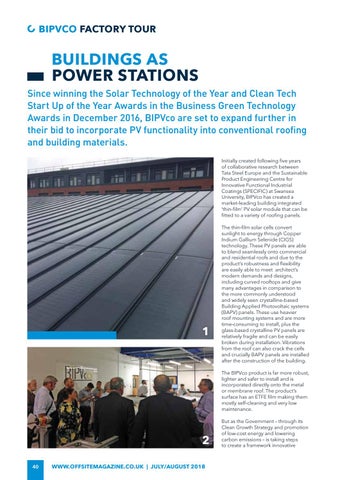BIPVCO FACTORY TOUR
BUILDINGS AS POWER STATIONS
Since winning the Solar Technology of the Year and Clean Tech Start Up of the Year Awards in the Business Green Technology Awards in December 2016, BIPVco are set to expand further in their bid to incorporate PV functionality into conventional roofing and building materials. Initially created following five years of collaborative research between Tata Steel Europe and the Sustainable Product Engineering Centre for Innovative Functional Industrial Coatings (SPECIFIC) at Swansea University, BIPVco has created a market-leading building integrated ‘thin-film’ PV solar module that can be fitted to a variety of roofing panels.
1
The thin-film solar cells convert sunlight to energy through Copper Indium Gallium Selenide (CIGS) technology. These PV panels are able to blend seamlessly onto commercial and residential roofs and due to the product’s robustness and flexibility are easily able to meet architect’s modern demands and designs, including curved rooftops and give many advantages in comparison to the more commonly understood and widely seen crystalline-based Building Applied Photovoltaic systems (BAPV) panels. These use heavier roof mounting systems and are more time-consuming to install, plus the glass-based crystalline PV panels are relatively fragile and can be easily broken during installation. Vibrations from the roof can also crack the cells and crucially BAPV panels are installed after the construction of the building. The BIPVco product is far more robust, lighter and safer to install and is incorporated directly onto the metal or membrane roof. The product’s surface has an ETFE film making them mostly self-cleaning and very low maintenance.
2 40
WWW.OFFSITEMAGAZINE.CO.UK | JULY/AUGUST 2018
But as the Government – through its Clean Growth Strategy and promotion of low-cost energy and lowering carbon emissions – is taking steps to create a framework innovative
